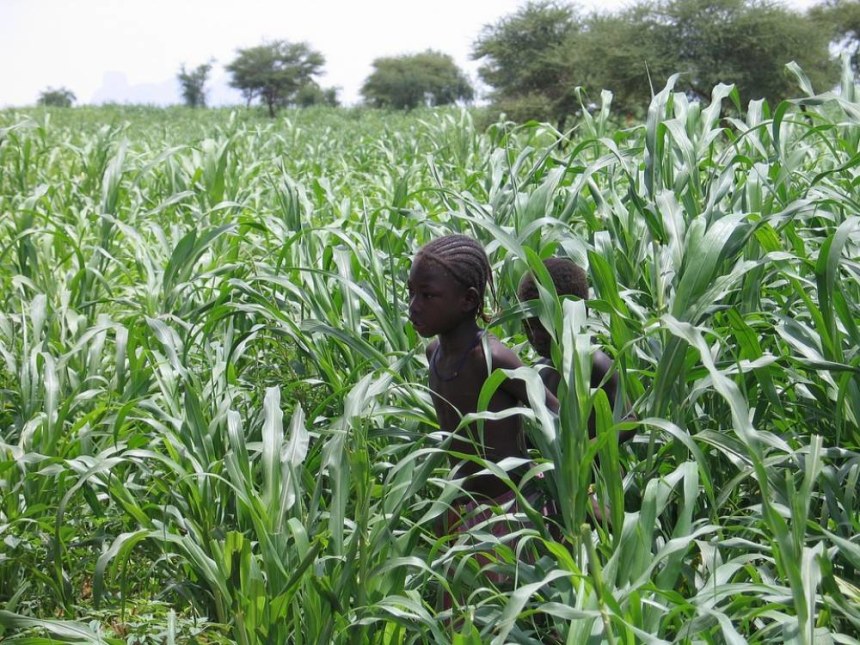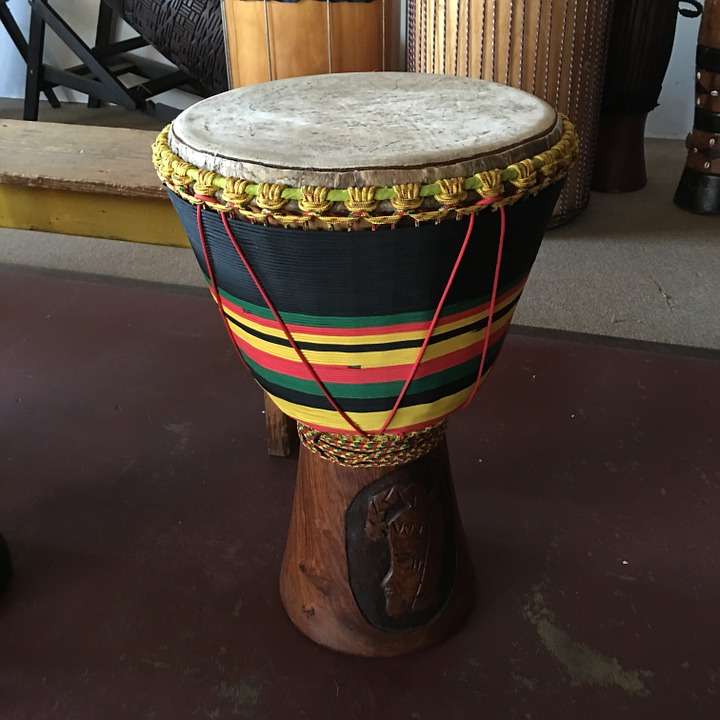
Bamako
The site of Bamako belonged to the pre-historical times as confirmed by the archaeological excavations of Magnambougou.
Bamako, derived from bambara or "bamako" (which means "Marigot of the Crocodile"), was founded at the end of the sixteenth century by Niare, formerly called Niakaté, who are originally Sarakolés. The crocodile was the fetish of Bamako and each year she was given a virgin maiden to eat.
Simballa Niakaté, a hunter from Lambidou (circle of Nioro, Kayes region), a Sarakole village, chose the site. But, it was his eldest son Diamoussa Niakaté commonly called Diamoussan Djan (because of its very large size), who founded Bamako. Niaréla, the district of Niare, is one of the oldest districts of Bamako. The three crocodiles that symbolize Bamako, originated from the three backwaters that crossed Bamako: Lido, Diafarana and Bèlèsôkô. The backwaters were about 500 meters east from the Friendship Hotel in Bamako (the result of Egyptian-Malian co-operation in the aftermath of independence) and then into the Niger.
At the end of the 19th century, Bamako was a large fortified village of 600 inhabitants, when on 1 February 1883 the French, with Borgnis-Desbordes, penetrated there.
This entry coincided with the birth of Amadou Coumba Niakaté (1883-1963), who became one of the very first teachers of Bamako, after being the first son of a traditional chief to attend the "School of the Whites". After the death of his older brother Maridie Niaré in 1956, Amadou Coumba Niakaté became the head of the province of Bamako. But he ruled only for two years before the abolition of the traditional chieftainship in 1958.
In 1895, it became the capital of a circle before becoming the capital of Upper Senegal-Niger on 17 October 1899 and then of French Sudan in 1920.
In 1904, the Dakar-Niger railway line was inaugurated. In 1905, the G-point Hospital was built. Between 1903 and 1907, the palace of Koulouba was built, the Presidential Palace, the Palace of the Governor, then the seat of the presidency of the republic from independence in 1960.
Local Culture of Mali
The culture of Mali, a vast landlocked country in West Africa, refers first to the observable cultural practices of its inhabitants. The multitude of ethnic groups and the historical heritage make it a rich and diversified culture, retaining both its traditions such as morality with griots or crafts and opening, literature, theater, cinema and photography; since its independence in 1960.
Post independence, Mali, a former French colony of French Sudan, had French as its official language. It is spoken only by a minority of the population
who prefer to express themselves in the different national languages. Bambara is the most widely spoken language in Mali. The other main languages are Fulani, Senufo, Soninke, Sahrah and Dogon The griots of Mali "djélit".
The "djélia", the art used by griots, consists in telling stories about families. Griots are present at every opportunity (marriage, baptism, religious holidays ...) so they are very familiar with the history of the families to which they are linked. When they are called, the griots remind the families of their past, that of their ancestors ... in a eulogistic way. It is customary for the person to whom the griot praises and gives him something (usually money, jewellery, clothes, etc.) to honor the memories evoked by the griot and show that the latter is worthy of the praises that are made to him.
Griots are therefore storytellers of the oral tradition, very strong in Mali. That is why these people are regarded as wells of knowledge and books of living stories. For many griots are the ancestors of the rappers and therefore "djélia" is the ancestor of rap, hence they praise and sing in a very special way. Their lyrics are like a stream that follows a rather repetitive instrumental rhythm by percussion.
Traditional Dance
In the Bambara ethnic group, a form of traditional theater called "koteba" is in practice. Every year, after the harvest, the villagers gather for a celebration where they dance, sing and perform a burlesque theater mix. Through sketches, we mock the villagers and their faults without ever naming anyone so as not to hurt. The Koteba makes it possible to preserve the unity of the village.
Other Traditional Instruments "The Balafon and The Kora"
• The Balafon
The balafon, bala or balani is an idiophone percussion instrument originating in West Africa. It is a kind of xylophone, either pentatonic or heptatonic. In Malinke, "balafon" comes from the terms bala (the instrument) and fon (sounds); there are balafons in many parts of Africa, all different from each other. Some are very sophisticated, some very simple; still others are gigantic.
The first balafon was born in the Kingdom of Sosso, between Guinea and Mali. This balafon still exists and is named Sosso Bala.
This instrument is quoted in the national anthem of Senegal "Pinch all your koras, hit the balafons"
Bala is the balafon with big calabashes, and wide blades (regions of Kolokani and Bobo djoulasso among others), to the serious sounds.
This balafon is sometimes called Bala dioula or Bala sénoufo. The number of blades it contains and the way it is tuned, varies according to the regions, but the balas of 14 to 18 blades in pentatonic agreement are the most frequent.
One plays either standing with straps supporting the balafon, or sitting, and is struck by means of two rods covered with rubber. An orchestra is often composed of three balafons, a bass, a medium and an acute accompanied by vertical djembe drums and tama armpit drum.
A festival devoted to it, triangle du balafon, takes place every year in Sikasso (Mali). Construction of a balafon museum is planned in Sikasso, Bougoula-Hameau.
The Djembe of Mali
Percussion carved in the traditional tie, decorated with petrol less usual such as Cai citron, ceni and dugura. Varnished, it does not require any special maintenance.
Dimensions:
- Diameter between 17 and 18 cm.
- Height between 34 and 35 cm.
The Kangaba percussions benefit from an irreproachable interior and exterior finishing treatment! The djembe is intended for “DJEMBEFOLA” which goes to the essential: simple design and irreproachable sound performances. Dance, robust, uncompromising musicality, this djembe is the very essence of Malian craftsmanship! Each djembe of Mali is conceived in the purest tradition of Malian craftsmen who use know-how and ancestral materials.
The Kora
The kora is a string instrument from West Africa. It is a Mandingo harp-lute (Senegal, Mali, Mauritania, Gambia, Guinea, Sierra Leone ...). According to legend, the first kora was the personal instrument of a genius - woman, who lived in the Kansala caves in The Gambia. Impressed and moved by the music of the instrument, a great warrior, Tiramakhan Traore, decided to dispossess the genius-woman. Aided by his fellow hunters, Waly Kelendjan and Djelimaly Oule Diabaté, he recovered the instrument that fell to Djelimaly, the griot of the group. Djelimaly transferred it to his son Kamba. And so she passed it on from father to son as far as Tilimaghan Diabaté, who introduced him to Mali.
Precious Stones from Mali
Mali is the third largest producer of stones in Africa, a large-scale exploration is underway. The country is famous for its gold since the time of the great Empire of Mali. During the pilgrimage to the Mecca of Emperor Kankou Moussa in 1324, his Caravan carried more than 8 tons of gold! Mali has therefore been a mining country for more than half a millennium.
Diamonds:
Mali has the potential to develop its diamond exploration. In Kayes (mining region 1), were discovered thirty 30 veins of quimberlíticos of which there are eight where diamonds can be seen. About eight small diamonds were found in Sikasso (southern Mali).
Mali Wonderful Natures
The Cliff of Bandiagara
Mali is a flat country slightly hilly, with altitudes generally between 250 and 500 meters. There are four major groups: the Sudano-Sahelian sandstone plateaux (Mandingo plateau, Bandiagara cliffs and Mount Hombori), the Sudano-Sahelian hills and plains, the Niger interior delta and the Adrar des Ifoghas massif with its ergs and authors.
Two large rivers cross Mali:
The Niger which travels Mali over 1,700 km, Bani is one of its tributaries. The Central Delta of Niger, between Timbuktu and Lere, is a vast area flooded after the rainy season. After the recession, the area is dotted with lakes, such as Lake Debo and Lake Figuibine.
The Niger River
The Senegal River
The Senegal, among its tributaries is the Bafing, the Baoulé and the Falémé.
Days of Colonization in Mali
Mali was the cradle of three great empires: the Empire of Ghana, the Empire of Mali and the Songhai Empire. It later became a French colony from 1895 to 1960. A few years after its independence on 22 September 1960, it underwent the dictatorship of Moussa Traoré before becoming a democratic regime (since the early 1990s). Mali Independence Monument stands as a mute witness.
Tower of The Roots of Slaves
In West Africa, the three most important empires of the Middle Ages (9th - 11th centuries), the Empire of Mali (13th - 15th centuries) and the Songhai Empire (15th - 16th centuries) all practiced slavery at Degrees. There were many black slaves, but also whites bought from Arab merchants who circulated across the Sahara or who were settled in West Africa. In the eleventh century, the Andalusian geographer El-Bekri evokes white slaves and black slaves in the kingdom of Aoudaghost. In the Empire of Ghana, gold was extracted by slaves. Others were employed as guards of the emperor. In the capital KUMBI SALEH, the population was divided by neighborhoods according to their ethnicity, clan or activities: the White Quarter was reserved for the Arabs. The majority of the inhabitants of the Empire were animist, but the Muslim minority was tolerated.




